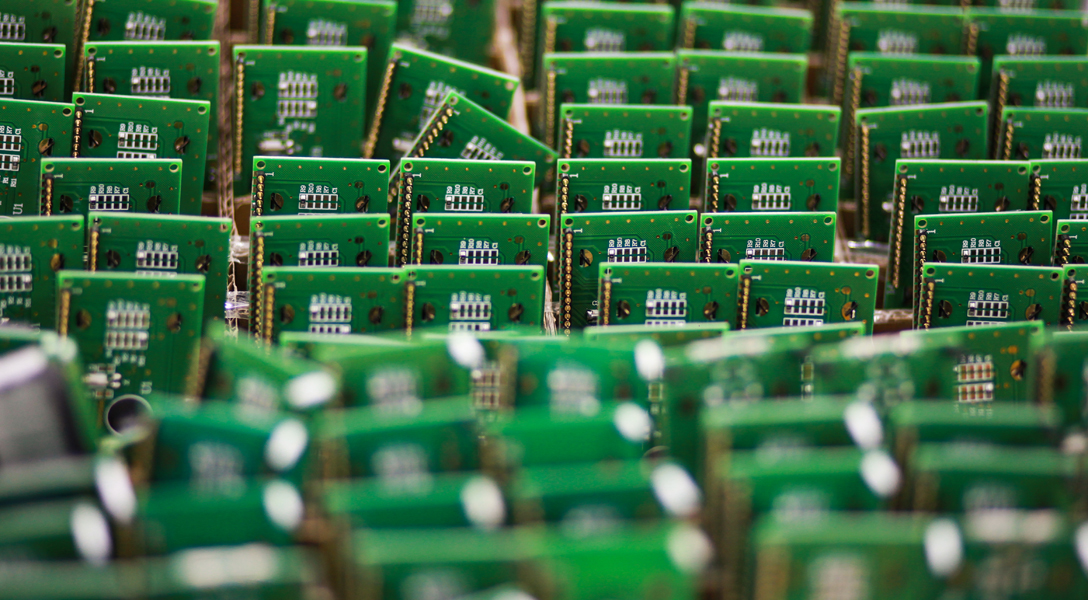
Texas high tech shakes off post-pandemic slump, readies new growth path
High tech represents nearly 5 percent of Texas’ gross domestic product and more than 9 percent of employment, both outsized shares relative to the U.S. The sector also contributes disproportionately to innovation and technological development and is crucial to productivity growth.
Tracking such activity and the overall high-tech sector is important not only because of its impact, but also because the sector is characterized by strong investment activity, rapid growth and high wages. Texas is well positioned to receive those benefits as it experiences continuing business relocations in addition to new investments in high-tech manufacturing capacity.High-tech hiring booms, busts in pandemic's wake
A high-tech company is one that manufactures or provides services involving computers, electronics, software, data, or scientific research and development. Such firms have a significant concentration of workers in science, technology, engineering and mathematics, known collectively as STEM occupations.
Job growth in high tech generally outpaces overall economic expansion in both the U.S. and Texas. In Texas, the high-tech sector added jobs at an average annual rate of 4.7 percent over the past decade, more than double the overall state job growth rate of 2.1 percent, according to payroll data from the Bureau of Labor Statistics.
In the wake of the pandemic, the sector experienced a hiring boom as high-tech companies expanded rapidly to keep up with surging demand for technology products and services from households and businesses (Chart 1).

Increased remote work eliminated geographic boundaries for many jobs, allowing tech companies to more rapidly increase their workforces from around the country.
However, many tech companies overhired. Concurrently, inflationary pressures on overall costs and rising wages, along with higher interest rates, squeezed margins. Layoffs followed across the sector.
Texas was spared the more significant high-tech layoffs that occurred in California in 2023 due in part to reallocation of tech activity from Silicon Valley to other parts of the country. Net job losses occurred in nearly all high-tech industries in California by the third quarter of 2022, while Texas tech sector cuts were not as pervasive. Texas computer manufacturing and tech consulting services employment gains offset some losses other tech industries experienced.
Texas tech layoff announcements spiked during the first half of 2023, foreshadowing job cuts in the third quarter (Chart 2). Such announcements usually precede actual employment separation by two to three months. Announcements declined in the second half of 2023 and have moderated thus far in 2024, suggesting the size of the local tech labor market may be stabilizing.

Texas high tech sees post-pandemic path
The Dallas Fed Texas Business Outlook Surveys (TBOS) provide additional insight into the activities of high-tech companies in the state. Roughly 65 firms in the surveys are identified as high-tech. About one-third are manufacturers, and the remaining two-thirds are in the service sector.
Business executives responding to TBOS indicate whether output at their company increased, decreased or remained unchanged relative to the prior month. A diffusion index is calculated by subtracting the share reporting a decrease from the share reporting an increase. Thus, diffusion index readings exceeding zero indicate an overall expansion in output, with higher readings suggestive of a faster pace of growth.
Growth in high-tech output, as measured by production and revenue, frequently outpaces manufacturing and services companies statewide (Chart 3).

High-tech companies’ relative standing slipped in mid-2021, as output growth decelerated sharply following widespread supply-chain constraints at the pandemic’s onset. Sector growth trailed the broader state economy for a year.
The semiconductor industry was particularly affected. Texas boasts the second largest semiconductor workforce in the nation (behind California). Semiconductor production couldn’t meet surging demand for home computing and electronic goods as well as autos.
The microchip shortage was complicated by transportation issues delaying imports from Asian producers. The consequences of the global microchip shortage cascaded over high-tech output and negatively affected other industries, notably auto manufacturing.
High tech reclaimed its role as a growth engine in mid-2022 as supply chain issues eased and output ran high, fulfilling backlogs. Toward the end of 2023, demand for manufactured goods declined and reduced activity, though high tech has outperformed other sectors once again in 2024.
The federal CHIPS and Science Act, signed into law Aug. 9, 2022, is expected to at least partially preclude future supply chain disruptions of the type the semiconductor industry encountered during the pandemic. The law also aims to protect the U.S. from risks associated with a strong reliance on international suppliers, particularly concentrated in Taiwan. Lower risks will likely come at a higher cost to producers and consumers, as U.S. production costs are likely to exceed those elsewhere.
Additionally, the Texas Legislature approved a separate Texas CHIPS Act in 2023. The law authorized creation of the Texas Semiconductor Innovation Fund to invest $1.4 billion for private firms to increase microchip manufacturing capacity and conduct research. New investments spurred by the CHIPS acts include Texas Instruments’ $30 billion semiconductor manufacturing plant in Sherman, Texas, 65 miles north of Dallas, and Samsung’s $44 billion investment in semiconductor facilities in Taylor, Texas, 35 miles northeast of Austin.
Migration of companies, workers fuels high-tech growth
Corporate relocations to Texas have partially spurred outsized growth in Texas’ high-tech sector, particularly in recent years.
Hewlett Packard Enterprise announced its relocation to Texas in 2020, while Apple unveiled a new campus and production facility in Austin in 2019. Google and SpaceX opened Austin-area facilities in 2021 as well.
Overall migration to Texas accelerated during the pandemic, with much of Texas’ population gains coming from people leaving California and New York. The inflows brought considerable talent from highly skilled labor markets on the coasts, particularly involving the high-tech sector. Net migration from the combined metro areas of San Francisco and San Jose (Silicon Valley) has been the biggest out-of-state contributor to Austin’s in-migration, doubling since the start of the pandemic.
Skilled labor pool, location flexibility drive high-tech wages
High-tech earnings exceed those in most other sectors, with 2022 hourly wages averaging $43.51 versus $29.26 for workers in Texas overall, according to Bureau of Labor Statistics’ data. The high-tech sector employs a larger share of highly skilled workers than most others, supporting the elevated pay.
The wage premium is even more pronounced in manufacturing, where high-tech workers earn 56 percent more than their counterparts in non-high-tech manufacturing.
The nature of how and where many high-tech-related activities can be performed also contributes to elevated pay. Much of it is accomplished offsite, and thus, these Texas companies are competing for workers residing in other areas such as California and New York where wage demands are greater.
TBOS data show that telecommuting is far more prevalent in high tech than in other sectors, with high-tech firms reporting 36 percent of their employees work fully remote, on average, versus 14 percent for companies overall (Chart 4). The percentage working from home could increase in the future, with U.S. firms anticipating slightly more remote work over the next five years.

TBOS high-tech companies say their top hiring impediment is not lack of applicants—as it is for other sectors—but workers looking for more pay than offered.
Looking closer at Texas’ high-tech sector
Home-grown companies, such as Texas Instruments and Dell, were pioneers in computer and electronic products manufacturing, the dominant high-tech subsector in Texas until 2010. It had comprised nearly half of state high-tech employment in 1990 and more than a third in 2000 (Chart 5).

Offshoring of U.S. manufacturing has contributed to this downward trend; manufacturing now accounts for just 14 percent of Texas tech employment.
Telecommunications giant Southwestern Bell (later SBC, now AT&T) moved its headquarters from St. Louis to San Antonio in 1993, boosting telecom’s footprint in Texas. (AT&T is now based in Dallas.) Telecommunications was the second largest tech subsector in Texas until 2007.
More recently, computer systems design and tech consulting services have become prominent in the state’s high-tech frontier, led by the Apple, Meta and Google expansions in Austin. High tech has become a pillar of Austin’s economy, where the share of high-tech jobs is double that of the U.S.
State well-positioned for emerging technologies
Texas is poised to lead in new advanced technologies, notably artificial intelligence (AI) and semiconductor manufacturing. The state is home to some of the most promising AI companies, and metro Austin is a notable early adopter and a dominant region in the nation’s emerging AI economy.
The federal CHIPS Act and increasing semiconductor business bolster the state’s leadership in the manufacture of the key hardware component critical to both emerging and legacy technologies.
Nearshoring in Mexico—firms shifting operations or suppliers from overseas locations—could further extend the global technology reach of Texas, the No. 1 U.S. exporting state to Mexico and the world.
When asked about the future, the high-tech company respondents to TBOS are markedly more optimistic than their counterparts in other sectors (Chart 6).

More than half (62 percent) of high-tech respondents expected their output to increase in the first half of 2024, according to responses to a TBOS special question posed in January. By comparison, 33 percent of manufacturers overall and 49 percent of services firms responded similarly. Such sentiment could be a precursor to further high-tech sector expansion.
About the authors



